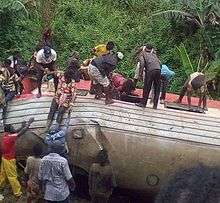2016 Eséka train derailment
Coordinates: 03°38′41″N 10°46′17″E / 3.64472°N 10.77139°E
 The train after derailment. Passengers can be seen helping other passengers still inside the train. | |
 Eséka Location within Cameroon | |
| Date | 21 October 2016 |
|---|---|
| Time | 11:00 WAT |
| Location | Eséka, Centre Region |
| Coordinates | 03°38′41″N 10°46′17″E / 3.64472°N 10.77139°E |
| Country | Cameroon |
| Rail line | Yaoundé - Douala |
| Operator | Camrail (Comazar) |
| Type of incident | Derailment |
| Cause | Under investigation |
| Statistics | |
| Trains | 1 |
| Passengers | ~1,300 |
| Deaths | 79[1] |
| Injuries | 551[1] |
On 21 October 2016, a Camrail inter-city passenger train travelling from Cameroon's capital Yaoundé to its largest city Douala derailed in Eséka, Centre Region. By 30 October 2016, the official number of casualties had reached 79 dead, with 550 injured.[2]
It was the deadliest rail accident on the African continent since the August 2007 Benaleka train accident.
Background
Camrail, which is a subsidiary company of the French Bolloré group, also operates Sitarail, the company that provides rail services in the former French colonies of Burkina Faso and Ivory Coast. Sitarail had a major accident in September 2016 when a bridge collapsed while one of Sitarail's trains travelled across it.[3][4] The accident caused the closure of the international rail-link between the West African countries.
The Bolloré group, led by French billionaire Vincent Bolloré (whose son, Cyrille Bolloré, is the director of Bolloré Transports and Logistics and has been responsible for Camrail's operations since January 2016[5]), also has plans to build and operate additional rail lines in French West Africa as part of the West Africa Regional Rail Integration plan.[6]
Accident
The passenger train involved in the accident was travelling on a Camrail line between the capital, Yaoundé, and the country's largest city and economic hub, Douala. Due to recent heavy rains, a bridge on the main road connecting the two cities got cut, forcing people to travel by train instead. As a result, Camrail extended the 9-carriages train with 8 additional carriages. The number of passengers on board was reported to be around 1,300, more than double the intended capacity of 600 of the unextended train, and the train left Yaoundé at 11:00 local time with a slight delay.[7] A Reuters journalist travelling on the train reported a loud noise and smoke as several of the carriages derailed around midday local time (11:00 GMT) in Eséka, about 120 km (75 mi) west of the capital.[8]
Victims were transported to a local hospital in Eséka, as well as to facilities in Douala. Social media images showed several carriages overturned on a slope beside the rail line, as hundreds of passengers looked on.[8] Because of the accident and the earlier bridge collapse, Cameroon's main transportation axis was effectively cut for the time being.[8]
Investigation
In the immediate aftermath of the accident, Camrail announced they will send investigative teams to the site, and expressed their condolences to victims' families in a post on the company's official Facebook page.[8] Rail officials said that prior to the train's departure from Yaoundé, eight additional carriages were added to the normally nine-car train in order to accommodate additional passengers, but it was not immediately known if that had caused or contributed to the crash.[7]
On the Tuesday following the crash a Cameroonian court announced that they would begin an investigation into who was at fault for the accident.[9] The following day Bolloré's Africa Chairman announced that the train had been traveling above the speed limit when it crashed.[10]
See also
- 2014 Katanga train derailment, a similar 2014 accident in the Democratic Republic of the Congo that killed 48
- List of rail accidents (2010–present)
- Rail transport in Cameroon
References
| Wikimedia Commons has media related to 2016 Eséka train derailment. |
- 1 2 (French) "Cameroun: 79 morts dans l'accident du train Yaoundé-Douala". Le Point. 24 October 2016. Archived from the original on 24 October 2016.
- ↑ "Accident de train au Cameroun: le bilan humain mis en doute". RFI-Afrique. 30 October 2016. Retrieved 7 November 2016.
- ↑ "Sitarail étudie «des solutions temporaires» après l'interruption du trafic ferroviaire entre Abidjan et Ouagadougou". Abidjan: Agence Afrique. 9 September 2016. Archived from the original on 23 October 2016.
- ↑ "Bridge collapse halts Ivorian-Burkina rail traffic". Africa Review. 8 September 2016. Retrieved 25 October 2016.
- ↑ Cameroun/Bolloré :Cyrille à l'épreuve du déraillement, La Tribune, publié le dimanche 23 octobre 2016 à 23h51
- ↑ Le train Bolloré à la conquête de l’Ouest africain, Publié le 29 December 2015, Mis à jour à 10h05 par Pierre Tillinac, Sud Ouest
- 1 2 "At least 53 killed in Cameroon train derailment". Al Jazeera. 21 October 2016. Archived from the original on 21 October 2016.
- 1 2 3 4 "Cameroon train crash death toll tops 70". Reuters. 22 October 2016. Archived from the original on 22 October 2016. Retrieved 22 October 2016.
- ↑ BBC, October 26 2016, Cameroon crash train 'broke speed limit'
- ↑ Dakaractu, 26 Octobre 2016, Cameroun : l’empire Bolloré contre-attaque